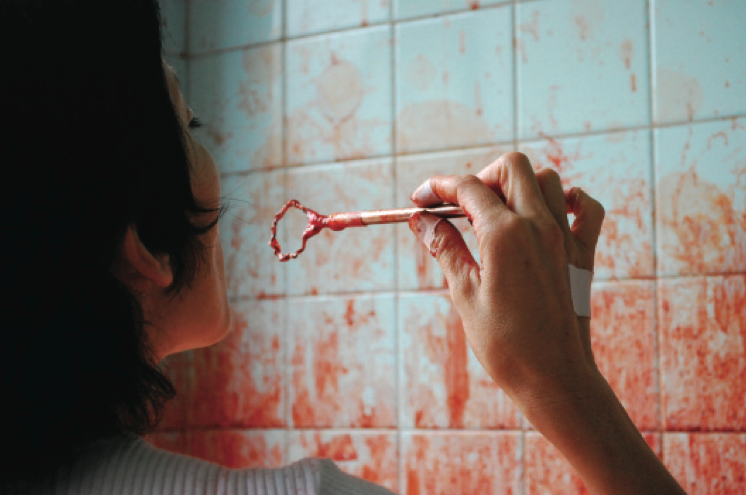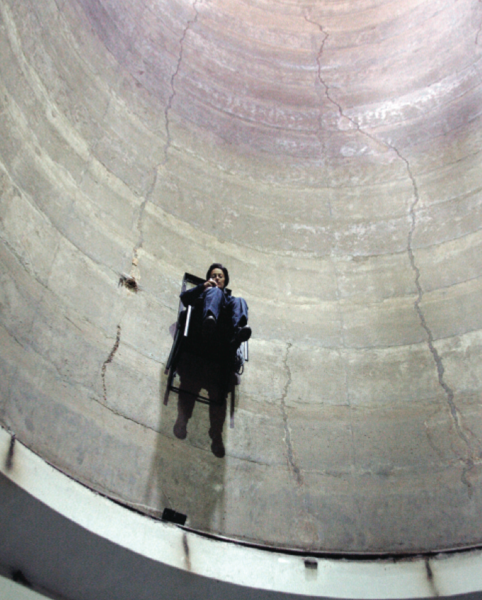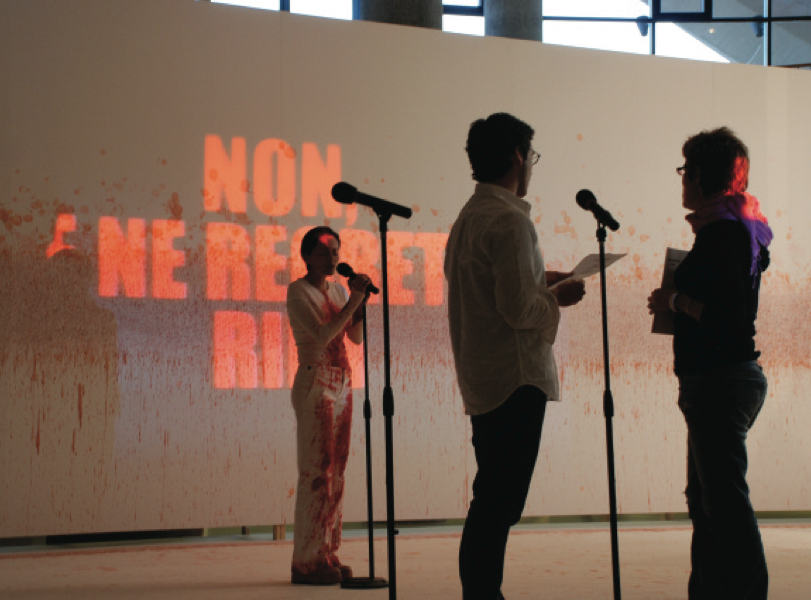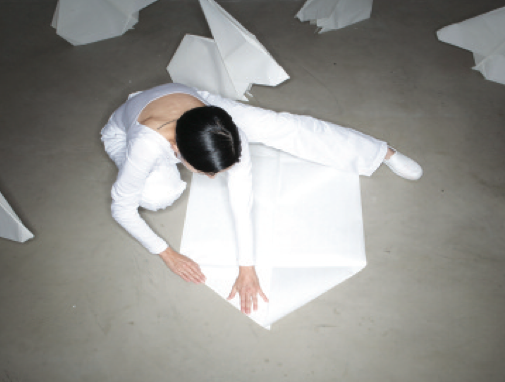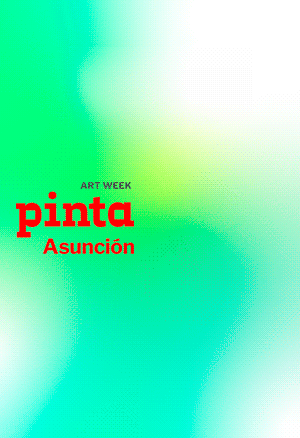María José Arjona
The Body as Sacred Axis of the World
André Leroi-Gourhan, a specialist in Paleolithic Art, pointed out that “the human act par excellence is perhaps not so much the creation of tools as the domestication of time and space, or, to put it differently, the creation of a human time and space”1. María José Arjona − one of the most powerful performance artists in the continent, selected for this reason to partake in Marina Abramovi ’s daring proposal for the Museum of Modern Art, New York, to pass on their legendary performances to a new generation of artists, actors, and dancers for them to reactivate them − transforms her own body into an axis mundi. That is, a centre of the world which, following Mircea Eliade’s definition, is “a sacred place above all things”, and from where she performs ceremonies of domestication of time and space.
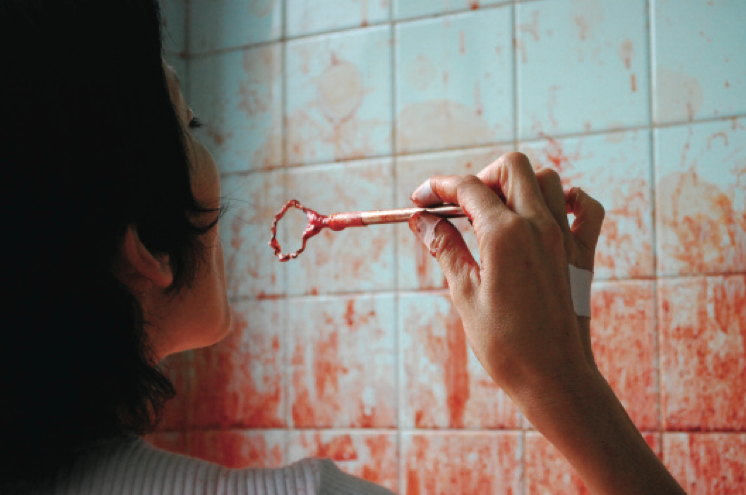
Since the beginning of her performance activities, in that axial territory a combat − a total game, given its intensity and concentration − has taken place between the presence of death, latent in the seed of human time, and the reaffirmation of life, experienced from the space of the body, which gradually dislodges fear. On activating Abramovic’s (2005/2010) re- performance, Nude with Skeleton, she becomes aware of this erotic relationship with death: “That companion that breathes inside you and sits where you sit and touches you all the time, that presence that permeates everything and needs your very life for it to be able to continue there, in the midst of the flight of an everyday reality that continually opens up to infinity”, she remarks. Her attempt to stop time in her own performances is parallel to the rhythmical and slow breathing by means of which she instills life into the skeleton of a stranger.
In her performance Lineamentun (2009), staged in an abandoned brewery − a space-time that makes reference to the failure of modernism in Colombia − she flooded the floor with water to transform it into a mirror reflecting the silo ceiling; she embedded a chair in the wall at a height of ten meters and, dressed in an overall belonging to the former workers, she climbed on the chair to conduct a ritual of gestures and sounds capable of creating a sacralized space and of transforming the temporal dimension. Throughout six hours she rubbed a Tibetan bowl in an endless circular movement to produce a reverberating sound. The hand did not only trace a resonating tunnel; it also traced a time tunnel: the brewery’s production, hitherto dead, was now being reactivated through art. Her body created a connection between floor and ceiling, above and below, in the revived silo.
Arjona structures her performances with a huge amount of poetry, but also with rigorous rational elements and a discipline that conveys austerity and self-control even onto the ritual works that include a symbolic shedding of blood. If she actually faces the limits of bodily resistance, unlike predecessors such as Gina Pane, she never inflicts any wounds, nor does she show the devastations on her skin. She renews the power of life.
Her life story includes training for a decade to be a dance and then suffering an abrupt accident that immobilized her for a year and cut her career short. The revealing vision of Frida Khalo’s La columna rota and the training in the strength of the gesture and the slowness of Butoh theatre led her to study at the School of Visual Arts in Bogota, Colombia, although she had never practiced drawing. Her long road toward personal healing went from the intuitive choice of prolonging the lines on the paper to the floor − where she moved clumsily − allowing herself to be guided only by physical instinct; to the the revelation that even though she would never dance, she would instead be able to diversify ad infinitum. She learned how to build for herself “thousands of bodies to expand to the world” with performance as her point of departure, and to go beyond individuality in order to unleash a process of social expression.
In Arjona, the memory of pain − experienced in the space of the body − is a dynamic instance that eventually extracts an unexpected potential from that which is most vulnerable. The forces of destruction and renovation she enacts are inscribed within different forms of a circularity that refers back to the universal and the timeless: her body, ready to “break free from singularity, from those identity modes tied to specific stereotypes”, such as gender or nationality, is the center of a microcosm that allows us to catch a glimpse of human atavism, of the immemorial relation of different types of violence (physical, emotional or social), but also of the healing forces. Personal and collective.
During her academic formative process, she used bandages, the objects she had kept since the days the surgery following her accident, to face her own physical frustration and her mental wound. She cut up the blood-stained bed sheet and resewed it, leaving the needles as threads marking the boundaries in a map of pain that seemed to float on a lace carpet found in the streets of the marginal area around the art school in Bogota. That key installation, performed at a time of uncertain social violence, preceded her graduation performance, Alimento, which was the initiation rite of consecration of the body that carried her on a journey through memory, with lookouts such as Joseph Beuys and Abramovi , into time immemorial, where the difference between animality and humanity was marked by the tools and by art, and she hunted a chigüiro2 with a bow and arrow in the Llanos Orientales.3
She shared its meat and kept its blood. In a house used to refrigerate carcasses, she covered the walls with an inch of protective grease, installed a clinking curtain made of forks which she suspended using dental floss, and in the middle of the spotless space − she has always resorted to the white cube to create a balance between intensity and the void − she undressed, she allowed her hands to be tied up, she walked along, letting each spectator perceive the beat of her heart, “so that he/she might feel that the offering was a living animal” and then, drop after drop, she covered herself with the blood of the hunted animal. A single ritual sacrifice in an environment where “deaths were so many and so unnecessary”, she evokes.
Since that come-back performance there have been others in which the artist pollutes white through the use of red liquids that resemble blood and performs universal memory rites and social healing rites. In one of the five performances which comprise The White Series −whose title alludes to an instance of silence, of liberation from the ties that language establishes with a specific context − Arjona blows red-tinted soap bubbles against the wall whereupon they burst, in a serial mechanism of constant repetition − a key to dissolve time − until producing the metaphorical image of a massacre which could be taking place elswhere at that same moment and with the participation of other bodies. In the following performance, she carried out the opposite operation after having the text that serves as its title − Remember to remember −tattooed on her back and the back of her neck. The bleaching, the healing of this vast metaphor for social violence, took place as she covered the wall with a layer of white chalk, writing the mentioned phrase over and over again, aware of the fact that the catharsis of horror is linked to the memory of language. Thus, incorporating words in the construction of the axial body, she healed a microcosm, the mirror of the world that has been desecrated.
In another performance in the same series, Karaoke, she evoked her feelings when, as a child, she listened to a song by Edith Piaf, the lyrics of which – “Non, je ne regrette rien” –, she did not understand, but which she learned by dint of repetition and now sang until her voice failed. The spectators read the lyrics in French and joined their voices in this ceremony over which she presided with her suit stained with red tint and white chalk, but covered with tulle. In this way she unleashed the ecstasy of collective rites via a multiple body, capable of encompassing “all the meanings, all the words, all the possible languages”.
This dialectic of solidity and fragility, of permanence and fleetingness, is a constant in her work, which contains a song celebrating the firm delicacy required to journey along life. And it is a kind of eroticism insofar as the experience of performance, which has the purity of the present time, and which ritualizes space, reunifies the body and life.
1 André Leroi-Gourhan. Gesture and Speech. Massachusetts Institute of Technology, 1993 (translated by Anna Bostock Berger).
2 Chigüiro: capibara (TN) 3 Llanos Orientales: Eastern Plains
Profile:
María José Arjona is a Colombian performance artist. She studied at the Superior Academy of Art in Bogota. In 2010, as part of the preliminary work for her participation in Marina Abramovic’s performance reenactment, both artists presented jointly the workshop Cleaning the House. In 2009 she was an artist-in-residence at the Robert Wilson ́s Watermill Arts Center, and she presented the performance Guardián Solar in the PerfomagiaArt Festival of the del Chopo University Museum, Juárez, Mexico City. Besides the performances presented in Miami galleries − as for example The White Series, at Gallery Diet; Messenger, at Fedric Snitzer Gallery, The Absent Puppetter, at Bernice Steinbaum Gallery; Time, at Damien-B Contemporary Art Center −she has staged numerous performances in museums and institutions. Among the latter, mention may be made of Alimento (1999, National Performance Festival, Cali, Colombia- 2000, Young Artists Salon - ASAB, Bogotá), 365 días (2001) Museum of Contemporary Art, Santa Martha (Colombia), Vivo (2004), El Museo del Barrio, New York; Body over Water (2005), The Ballroom Marfa, Texas, USA, and Crow-Condor Project (2002), at the Performance Art Festival featured by La Tertulia Museum of Contemporary Art, Cali, Colombia.

